by Jason Bodner
January 17, 2024
Every day, our computers fire up and the emails start flying. Given our reliance on computers, it’s wild to think that the computer isn’t all that old. In January 1946, the first computer was built in Pennsylvania at the Moore School of Engineering. Moore’s law says the number of transistors in an integrated circuit (IC) doubles about every two years. By the law of compound interest, that means that if the first computer started with a single transistor, we’d be looking at computers with two to the 39th power, or 550 billion.
Sure enough, the M1 Ultra by Apple is in the statistical ballpark: It has 114 billion transistors on a dual-die system on a chip with a density of 171 million transistors per square millimeter.
That type of growth can easily be seen reflected in long-term charts of the best tech stocks as well.
Stock trading in the second week of 2024 is behind us. It was an important week because the first week is often characterized by lower liquidity and higher volatility. But capital must be deployed per the charters of investment firms. Investment managers don’t get paid for just holding cash. So, these early moves in the year are great fodder for understanding the broader views of the investing professionals and public for the year ahead. Naturally, my research relies heavily on computers. The joy is that computers never sleep. They ran all through the holiday season, too. What they told me is interesting…
First of all, the Big Money Index (BMI) remains heavily overbought:
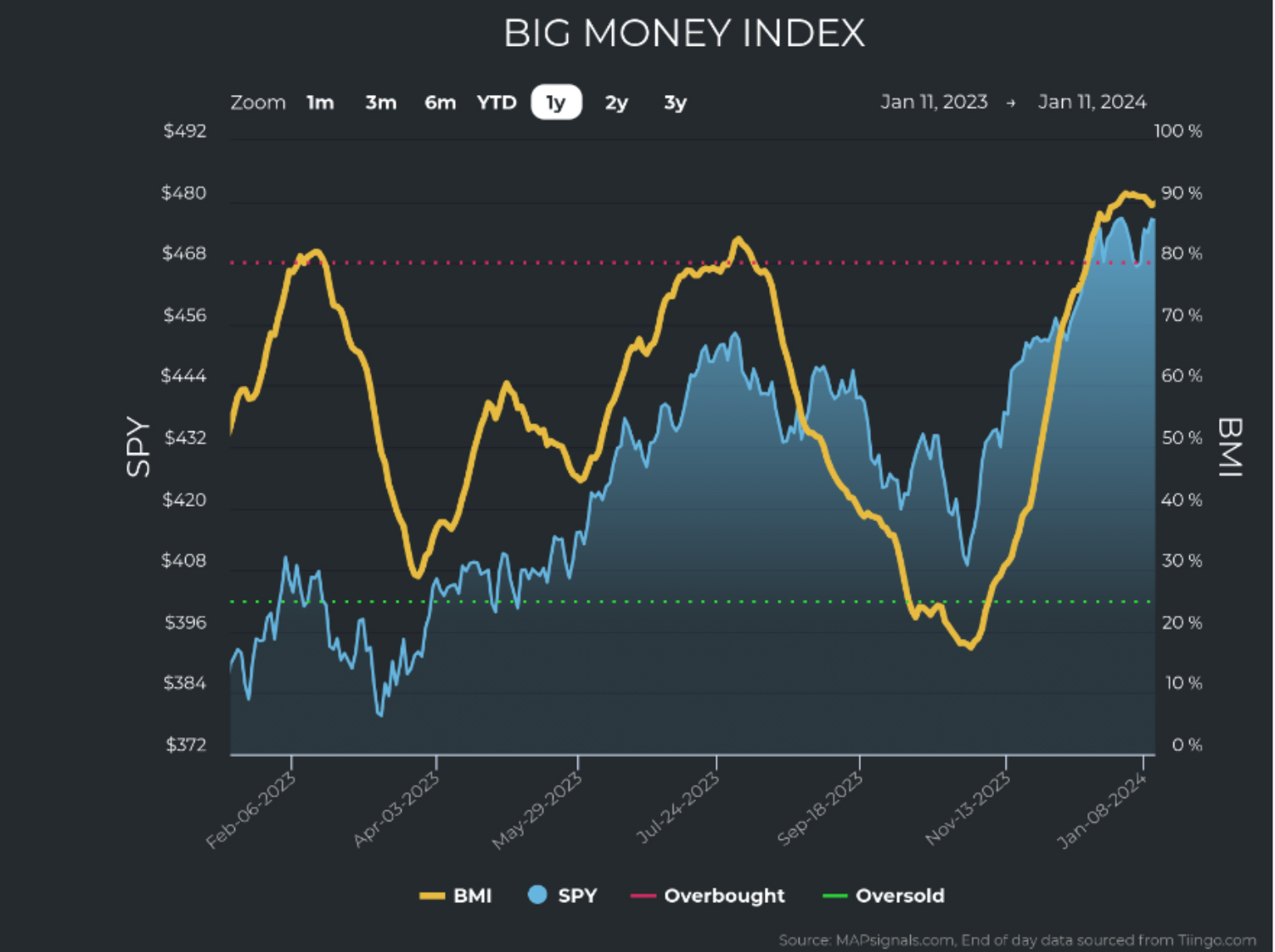
Graphs are for illustrative and discussion purposes only. Please read important disclosures at the end of this commentary.
At risk of redundancy, the important takeaway here is that the BMI can stay overbought for a long time. Right after COVID, it was in overbought territory for a shocking four months. There’s no telling how long it will stay overbought this time, but the important thing is to watch when it falls from overbought: that’s the sign of a weakening market. So, until we see that, I am not sounding any alarm bells.
After an initial bump of volatility in the first week of January, last week shows us what a more “normal” week looks like. Markets rallied, and buy signals are starting to crop up. That makes sense as capital gets deployed from investment managers. ETFs are also seeing mild buying.
What interests me even more is the unusual trading activity. After a new year lull in volume, we see a healthy spike in volumes with a rising market. The amber bars below show that inflows are lifting markets: i.e. the rally is not based on soft volume.
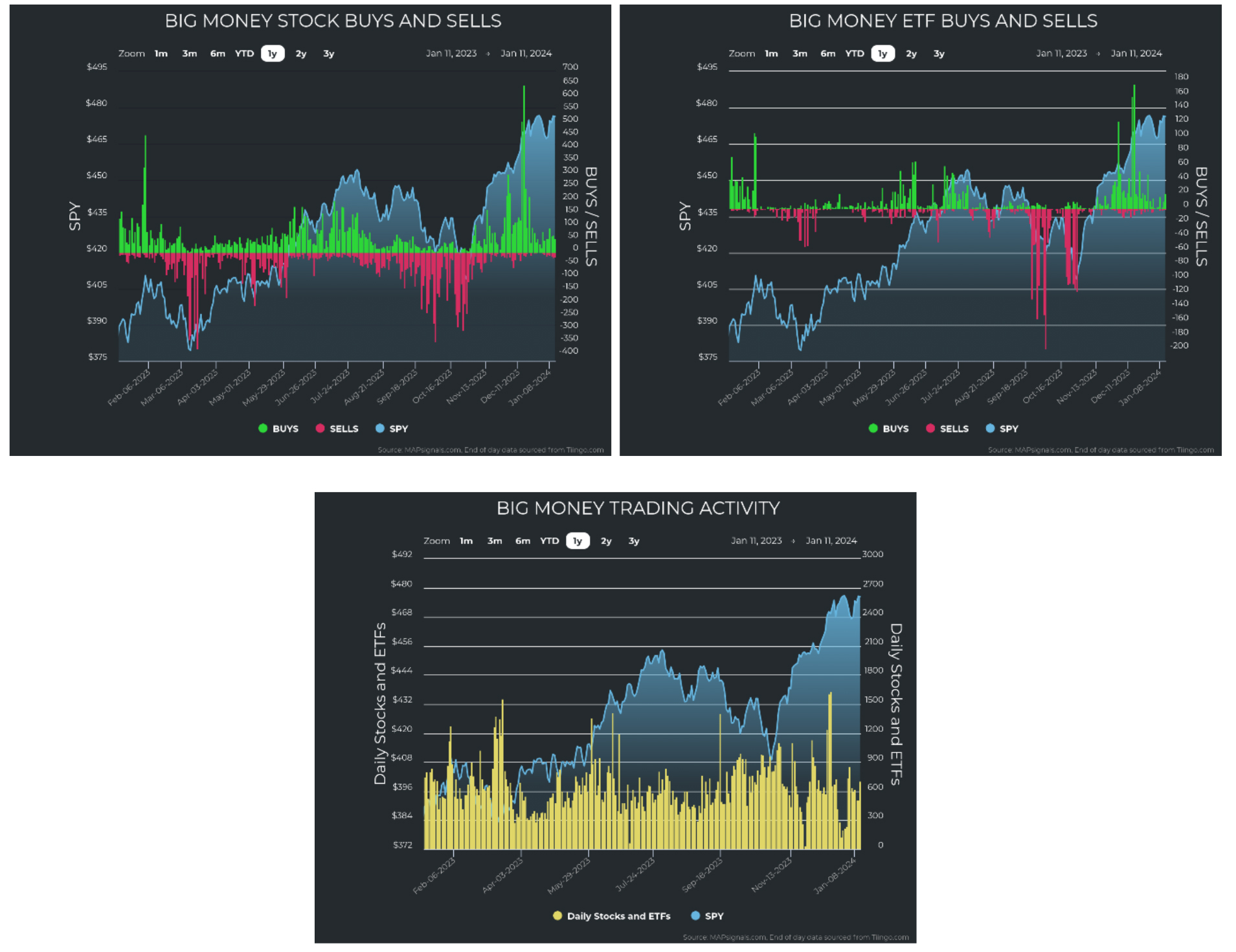
Graphs are for illustrative and discussion purposes only. Please read important disclosures at the end of this commentary.
If we look at the buying and selling since January 1st to see how it is distributed, we see constructive bullish activity. First off, we see small and mi-caps getting significant inflows. Large caps also attracted capital. Notice the low levels of selling, too:

Graphs are for illustrative and discussion purposes only. Please read important disclosures at the end of this commentary.
Now, for a quick breakdown as to where the money has been flowing, we can consult our charts of sector buys and sells. Here we see that since January 1st, Health Care stocks have been bought more than any other sector. This is interesting because we are in an election year. Health Care has been one of the strongest performing sectors since the October lows. But in election years since 1980, Health Care stocks have performed very well, especially in 1st quarters. This is following the script:
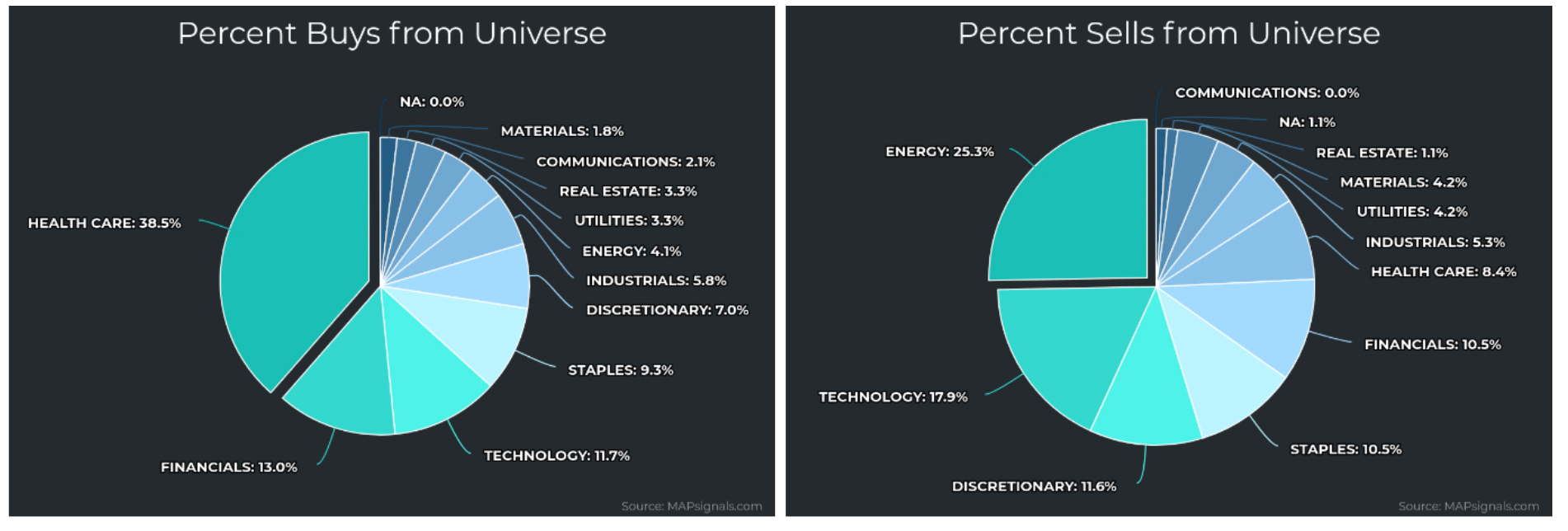
Graphs are for illustrative and discussion purposes only. Please read important disclosures at the end of this commentary.
The chart on the right depicts selling activity in a pie chart. There have been only 94 unusual sell signals since 2024 began. Despite the pie cart looking ominous for energy stocks, there have been only 24 energy stocks sold in unusual volume, and 100% of a small number is still a small number. Compare this to 514 unusual buys over the same time. Nearly 40% of those have been health care stocks.
Next, let’s review the sector strength and weakness. Again, January is a tumultuous time for the sector ranking table. This is because there is a year-to-date performance component in stock scoring which resets each January 1st. As the year rolls on, things stabilize. Already we are seeing things fall in line with the end of last year. Technology rose to the top spot. But look how strong Health Care has become:
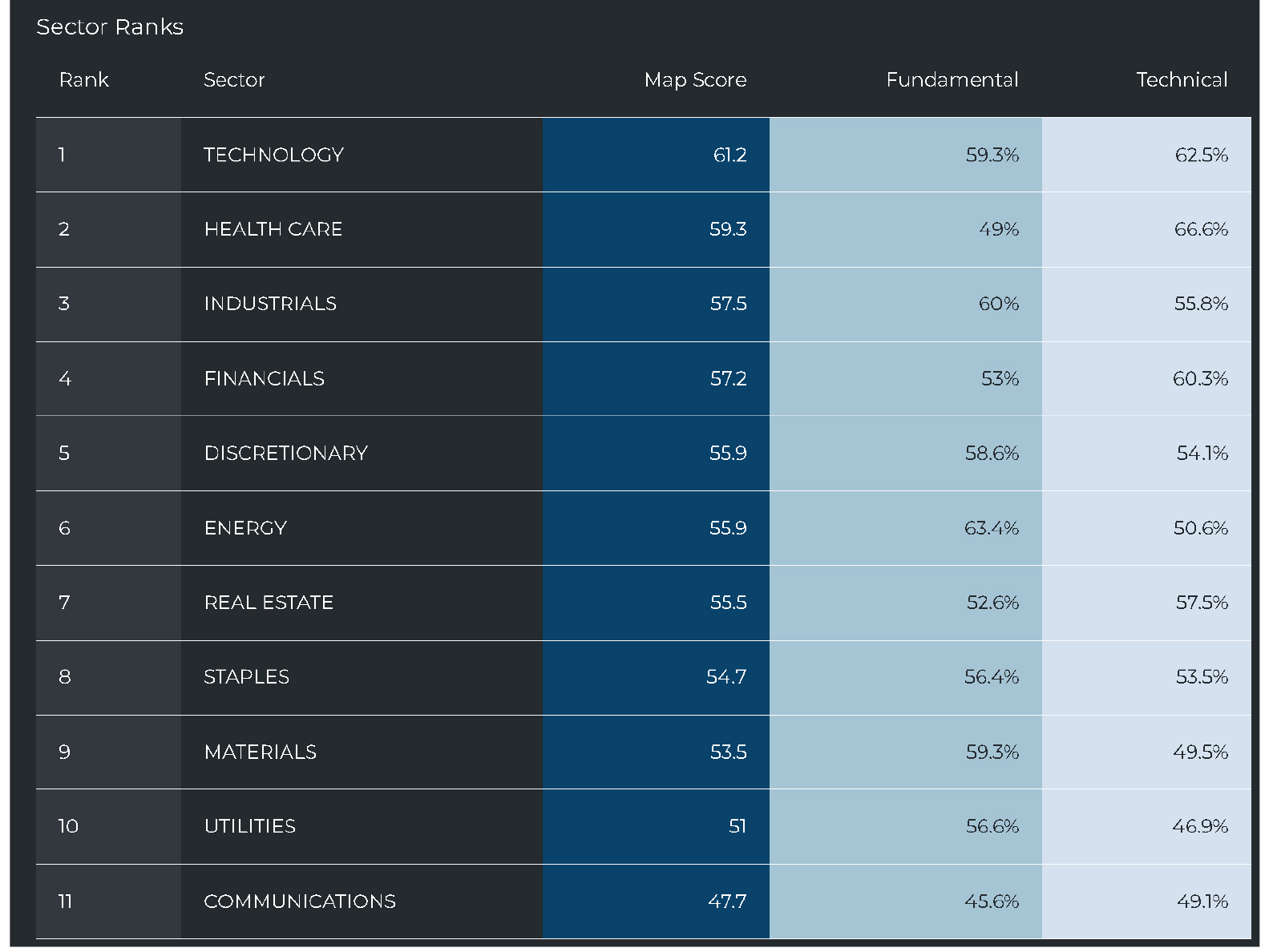
Graphs are for illustrative and discussion purposes only. Please read important disclosures at the end of this commentary.
As I scanned each sector for how industry groups were performing, I saw the following trends:
• Miners are weak.
• Insurance and equity REITs are strong.
• Home builders are strong.
• Department stores and retailers are weak.
• Software and networks are strong.
• Telecoms are weak.
Looking at individual sector performance, my big takeaway was two-fold: There is light buying across the sectors. This makes sense as in order to generate new unusual buy signals, new highs must be breached.
The second takeaway, is that the only sector that saw any selling was Energy. And given the US and UK airstrike response to the Houthi attacks, energy stocks firmed up on oil’s sudden price spike in reaction.

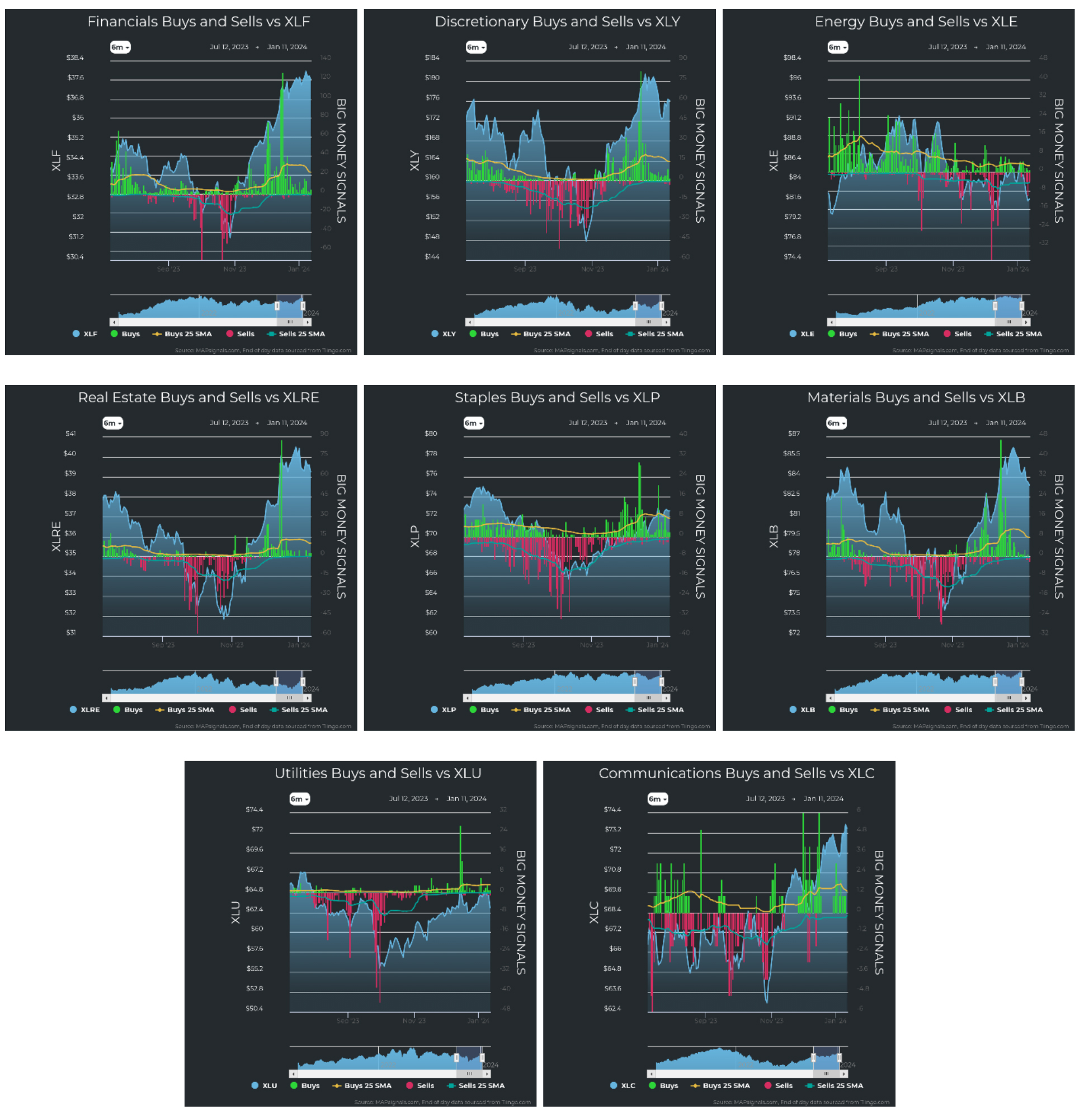
Graphs are for illustrative and discussion purposes only. Please read important disclosures at the end of this commentary.
So far so good in 2024. Buying is stable, selling is low, and we remain in a strong overbought market that can stay overbought for a while. I expect volatility. But for now, we sit back and enjoy the ride.
Risk to profits and capital is always part of the game. But if you hope to avoid risk altogether, remember Flip Wilson advises, “You can’t expect to hit the jackpot if you don’t put a few nickels in the machine.”
All content above represents the opinion of Jason Bodner of Navellier & Associates, Inc.
Also In This Issue
A Look Ahead by Louis Navellier
Why the Fed Follows the PCE, not the CPI or PPI
Income Mail by Bryan Perry
Bracing For More Volatility Ahead
Growth Mail by Gary Alexander
Why the Fed Lost Over $116 Billion in 2023
Global Mail by Ivan Martchev
U.S. M2 Money Supply is Still Shrinking
Sector Spotlight by Jason Bodner
How Long Can This Market Stay Overbought?
View Full Archive
Read Past Issues Here

Jason Bodner
MARKETMAIL EDITOR FOR SECTOR SPOTLIGHT
Jason Bodner writes Sector Spotlight in the weekly Marketmail publication and has authored several white papers for the company. He is also Co-Founder of Macro Analytics for Professionals which produces proprietary equity accumulation/distribution research for its clients. Previously, Mr. Bodner served as Director of European Equity Derivatives for Cantor Fitzgerald Europe in London, then moved to the role of Head of Equity Derivatives North America for the same company in New York. He also served as S.V.P. Equity Derivatives for Jefferies, LLC. He received a B.S. in business administration in 1996, with honors, from Skidmore College as a member of the Periclean Honors Society. All content of “Sector Spotlight” represents the opinion of Jason Bodner
Important Disclosures:
Jason Bodner is a co-founder and co-owner of Mapsignals. Mr. Bodner is an independent contractor who is occasionally hired by Navellier & Associates to write an article and or provide opinions for possible use in articles that appear in Navellier & Associates weekly Market Mail. Mr. Bodner is not employed or affiliated with Louis Navellier, Navellier & Associates, Inc., or any other Navellier owned entity. The opinions and statements made here are those of Mr. Bodner and not necessarily those of any other persons or entities. This is not an endorsement, or solicitation or testimonial or investment advice regarding the BMI Index or any statements or recommendations or analysis in the article or the BMI Index or Mapsignals or its products or strategies.
Although information in these reports has been obtained from and is based upon sources that Navellier believes to be reliable, Navellier does not guarantee its accuracy and it may be incomplete or condensed. All opinions and estimates constitute Navellier’s judgment as of the date the report was created and are subject to change without notice. These reports are for informational purposes only and are not a solicitation for the purchase or sale of a security. Any decision to purchase securities mentioned in these reports must take into account existing public information on such securities or any registered prospectus.To the extent permitted by law, neither Navellier & Associates, Inc., nor any of its affiliates, agents, or service providers assumes any liability or responsibility nor owes any duty of care for any consequences of any person acting or refraining to act in reliance on the information contained in this communication or for any decision based on it.
Past performance is no indication of future results. Investment in securities involves significant risk and has the potential for partial or complete loss of funds invested. It should not be assumed that any securities recommendations made by Navellier. in the future will be profitable or equal the performance of securities made in this report. Dividend payments are not guaranteed. The amount of a dividend payment, if any, can vary over time and issuers may reduce dividends paid on securities in the event of a recession or adverse event affecting a specific industry or issuer.
None of the stock information, data, and company information presented herein constitutes a recommendation by Navellier or a solicitation to buy or sell any securities. Any specific securities identified and described do not represent all of the securities purchased, sold, or recommended for advisory clients. The holdings identified do not represent all of the securities purchased, sold, or recommended for advisory clients and the reader should not assume that investments in the securities identified and discussed were or will be profitable.
Information presented is general information that does not take into account your individual circumstances, financial situation, or needs, nor does it present a personalized recommendation to you. Individual stocks presented may not be suitable for every investor. Investment in securities involves significant risk and has the potential for partial or complete loss of funds invested. Investment in fixed income securities has the potential for the investment return and principal value of an investment to fluctuate so that an investor’s holdings, when redeemed, may be worth less than their original cost.
One cannot invest directly in an index. Index is unmanaged and index performance does not reflect deduction of fees, expenses, or taxes. Presentation of Index data does not reflect a belief by Navellier that any stock index constitutes an investment alternative to any Navellier equity strategy or is necessarily comparable to such strategies. Among the most important differences between the Indices and Navellier strategies are that the Navellier equity strategies may (1) incur material management fees, (2) concentrate its investments in relatively few stocks, industries, or sectors, (3) have significantly greater trading activity and related costs, and (4) be significantly more or less volatile than the Indices.
ETF Risk: We may invest in exchange traded funds (“ETFs”) and some of our investment strategies are generally fully invested in ETFs. Like traditional mutual funds, ETFs charge asset-based fees, but they generally do not charge initial sales charges or redemption fees and investors typically pay only customary brokerage fees to buy and sell ETF shares. The fees and costs charged by ETFs held in client accounts will not be deducted from the compensation the client pays Navellier. ETF prices can fluctuate up or down, and a client account could lose money investing in an ETF if the prices of the securities owned by the ETF go down. ETFs are subject to additional risks:
- ETF shares may trade above or below their net asset value;
- An active trading market for an ETF’s shares may not develop or be maintained;
- The value of an ETF may be more volatile than the underlying portfolio of securities the ETF is designed to track;
- The cost of owning shares of the ETF may exceed those a client would incur by directly investing in the underlying securities; and
- Trading of an ETF’s shares may be halted if the listing exchange’s officials deem it appropriate, the shares are delisted from the exchange, or the activation of market-wide “circuit breakers” (which are tied to large decreases in stock prices) halts stock trading generally.
Grader Disclosures: Investment in equity strategies involves substantial risk and has the potential for partial or complete loss of funds invested. The sample portfolio and any accompanying charts are for informational purposes only and are not to be construed as a solicitation to buy or sell any financial instrument and should not be relied upon as the sole factor in an investment making decision. As a matter of normal and important disclosures to you, as a potential investor, please consider the following: The performance presented is not based on any actual securities trading, portfolio, or accounts, and the reported performance of the A, B, C, D, and F portfolios (collectively the “model portfolios”) should be considered mere “paper” or pro forma performance results based on Navellier’s research.
Investors evaluating any of Navellier & Associates, Inc.’s, (or its affiliates’) Investment Products must not use any information presented here, including the performance figures of the model portfolios, in their evaluation of any Navellier Investment Products. Navellier Investment Products include the firm’s mutual funds and managed accounts. The model portfolios, charts, and other information presented do not represent actual funded trades and are not actual funded portfolios. There are material differences between Navellier Investment Products’ portfolios and the model portfolios, research, and performance figures presented here. The model portfolios and the research results (1) may contain stocks or ETFs that are illiquid and difficult to trade; (2) may contain stock or ETF holdings materially different from actual funded Navellier Investment Product portfolios; (3) include the reinvestment of all dividends and other earnings, estimated trading costs, commissions, or management fees; and, (4) may not reflect prices obtained in an actual funded Navellier Investment Product portfolio. For these and other reasons, the reported performances of model portfolios do not reflect the performance results of Navellier’s actually funded and traded Investment Products. In most cases, Navellier’s Investment Products have materially lower performance results than the performances of the model portfolios presented.
This report contains statements that are, or may be considered to be, forward-looking statements. All statements that are not historical facts, including statements about our beliefs or expectations, are “forward-looking statements” within the meaning of The U.S. Private Securities Litigation Reform Act of 1995. These statements may be identified by such forward-looking terminology as “expect,” “estimate,” “plan,” “intend,” “believe,” “anticipate,” “may,” “will,” “should,” “could,” “continue,” “project,” or similar statements or variations of such terms. Our forward-looking statements are based on a series of expectations, assumptions, and projections, are not guarantees of future results or performance, and involve substantial risks and uncertainty as described in Form ADV Part 2A of our filing with the Securities and Exchange Commission (SEC), which is available at www.adviserinfo.sec.gov or by requesting a copy by emailing info@navellier.com. All of our forward-looking statements are as of the date of this report only. We can give no assurance that such expectations or forward-looking statements will prove to be correct. Actual results may differ materially. You are urged to carefully consider all such factors.
FEDERAL TAX ADVICE DISCLAIMER: As required by U.S. Treasury Regulations, you are informed that, to the extent this presentation includes any federal tax advice, the presentation is not written by Navellier to be used, and cannot be used, for the purpose of avoiding federal tax penalties. Navellier does not advise on any income tax requirements or issues. Use of any information presented by Navellier is for general information only and does not represent tax advice either express or implied. You are encouraged to seek professional tax advice for income tax questions and assistance.
IMPORTANT NEWSLETTER DISCLOSURE:The hypothetical performance results for investment newsletters that are authored or edited by Louis Navellier, including Louis Navellier’s Growth Investor, Louis Navellier’s Breakthrough Stocks, Louis Navellier’s Accelerated Profits, and Louis Navellier’s Platinum Club, are not based on any actual securities trading, portfolio, or accounts, and the newsletters’ reported hypothetical performances should be considered mere “paper” or proforma hypothetical performance results and are not actual performance of real world trades. Navellier & Associates, Inc. does not have any relation to or affiliation with the owner of these newsletters. There are material differences between Navellier Investment Products’ portfolios and the InvestorPlace Media, LLC newsletter portfolios authored by Louis Navellier. The InvestorPlace Media, LLC newsletters contain hypothetical performance that do not include transaction costs, advisory fees, or other fees a client might incur if actual investments and trades were being made by an investor. As a result, newsletter performance should not be used to evaluate Navellier Investment services which are separate and different from the newsletters. The owner of the newsletters is InvestorPlace Media, LLC and any questions concerning the newsletters, including any newsletter advertising or hypothetical Newsletter performance claims, (which are calculated solely by Investor Place Media and not Navellier) should be referred to InvestorPlace Media, LLC at (800) 718-8289.
Please note that Navellier & Associates and the Navellier Private Client Group are managed completely independent of the newsletters owned and published by InvestorPlace Media, LLC and written and edited by Louis Navellier, and investment performance of the newsletters should in no way be considered indicative of potential future investment performance for any Navellier & Associates separately managed account portfolio. Potential investors should consult with their financial advisor before investing in any Navellier Investment Product.
Navellier claims compliance with Global Investment Performance Standards (GIPS). To receive a complete list and descriptions of Navellier’s composites and/or a presentation that adheres to the GIPS standards, please contact Navellier or click here. It should not be assumed that any securities recommendations made by Navellier & Associates, Inc. in the future will be profitable or equal the performance of securities made in this report.
FactSet Disclosure: Navellier does not independently calculate the statistical information included in the attached report. The calculation and the information are provided by FactSet, a company not related to Navellier. Although information contained in the report has been obtained from FactSet and is based on sources Navellier believes to be reliable, Navellier does not guarantee its accuracy, and it may be incomplete or condensed. The report and the related FactSet sourced information are provided on an “as is” basis. The user assumes the entire risk of any use made of this information. Investors should consider the report as only a single factor in making their investment decision. The report is for informational purposes only and is not intended as an offer or solicitation for the purchase or sale of a security. FactSet sourced information is the exclusive property of FactSet. Without prior written permission of FactSet, this information may not be reproduced, disseminated or used to create any financial products. All indices are unmanaged and performance of the indices include reinvestment of dividends and interest income, unless otherwise noted, are not illustrative of any particular investment and an investment cannot be made in any index. Past performance is no guarantee of future results.
